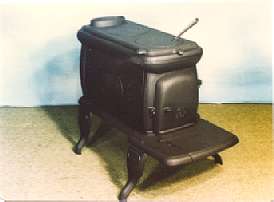Wood Burning Stoves
Space heating, cooking, baking, and solar hot water boosting can all provided by a wood-fired, slow-combustion oven. The oven should be situated in the centre of the living area and is typically used during the four winter months.
At the Kyoto conference the European Union agreed to an overall reduction in Greenhouse Gases of 8% by 2010. The UK share was a reduction of 12.5%.
- Wood is a renewable energy resource, and because trees recycle carbon dioxide, wood burning does not contribute to the global warming problem.
- By using this form of energy production we will be doing our bit to help.
- The radiant heat from a stove or fireplace is like the rays of the sun. It warms you through and through. Come in from the storm and stand near the fire rubbing your hands together. It’s one of life’s small pleasures.
- Spend a penny on oil, natural gas or electricity and you feed a corporate giant. Spend a penny on firewood and you feed a neighbour. Save a penny by heating with wood and you can spend that penny in your community. Heating with wood makes you richer in ways beyond counting
Abstract
Although wood was the main fuel source in this country until the Industrial Revolution, and still is in many parts of the world, in the UK we currently obtain less than 1% of our primary fuel from this source
Many traditional wood burning processes are inefficient in their use of fuel and cause atmospheric pollution. However, modern technology, such as woodchip boilers, have both greatly improved efficiency and significantly reduced pollution levels. Moreover the technology can now be considered for more widespread use.
New designs
There have been major advances in wood burning over the past five years. These have made wood burning more effective, efficient and convenient than ever before. Some of these advances include:
- new internal designs capable of burning the wood more completely, cleanly and at higher efficiencies;
- a new technology that keeps the door glass clear for days at a time, allowing efficient heating to be combined with viewing of the flame;
- pellet stoves that use compressed wood and other suitable biomass wastes, capable of providing at least 24 hours of unattended heating;
- New installation safety standards that provide clear guidelines for safe installation; and training programs for installers and inspectors that allow you to get dependable advice and service.


